Which countries’ residents live the longest lives, and why?
It’s common knowledge that life expectancy is not uniform across the globe. However, even when only looking at more highly developed countries, the extent to which life expectancy varies is surprising.
Many factors can influence a population's life expectancy, including genetics, diet, environment, healthcare, and other socioeconomic elements. For instance, easily accessible and affordable prescription drugs could increase a population’s health and help them counter treatable and preventable conditions like asthma, allergies, and chronic conditions.
With this in mind, we wanted to highlight life expectancy estimations and disparities between different countries while also exploring how they differ for several high-profile causes of death. We’ll also examine how the United States stacks up against other developed countries for each factor, considering its position as the world’s largest economy and its more than 40% share of the global pharmaceutical industry.
Japan has the longest life expectancy at 84.5 years
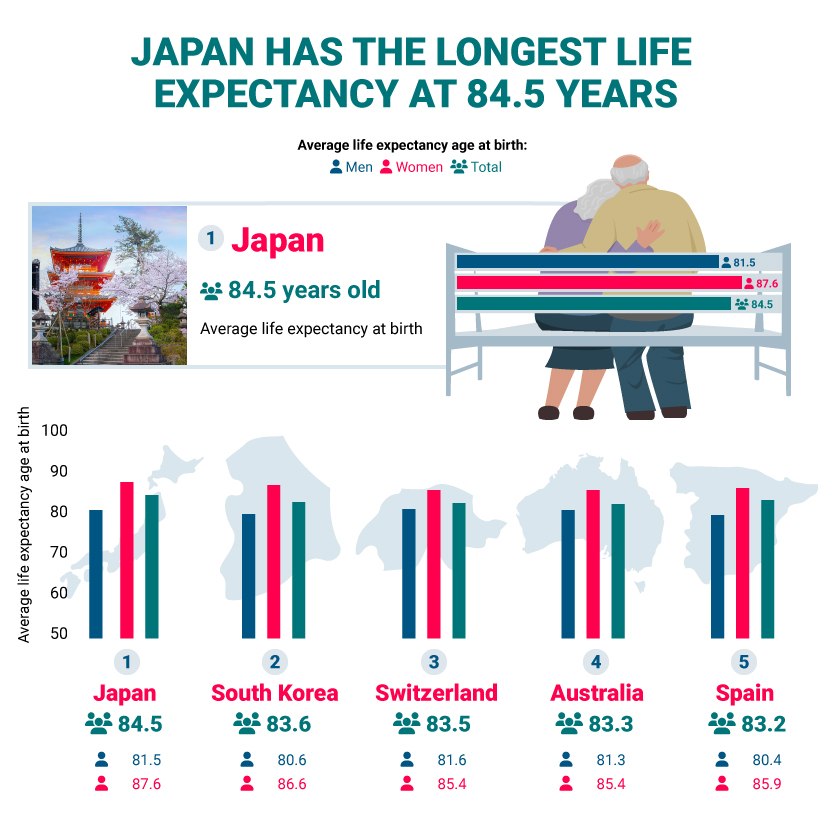

The data we examined for life expectancy at birth covered 47 countries, including all OECD countries and several other influential and developed nations. The average life expectancy across all countries in our study was 78.1 years, while the median was 80.7 years, as seen in Germany and Greece.
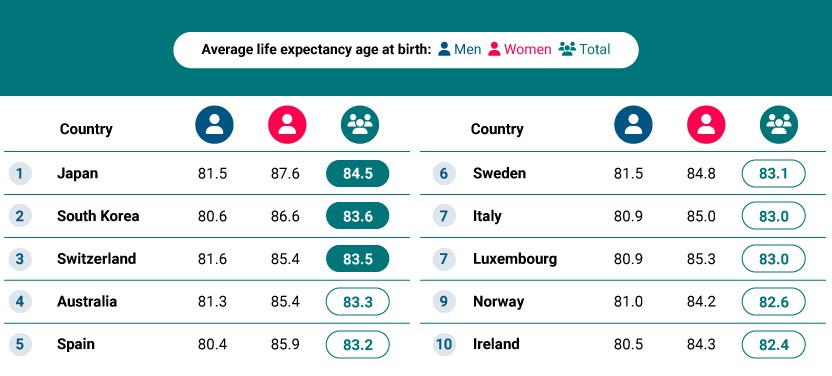

- Japan
Average life expectancy at birth: 84.5 years
Japan has the longest average life expectancy at birth, with Japanese newborns forecast to live 84.5 years. This figure is even higher for women, reaching 87.6 years, while men are expected to live for 81.5 years, on average.
Japan is a country known for its long-lived population, and many reasons have been given for this longevity. A popular opinion is that the Japanese diet and food quality are significant contributors to the country’s long life expectancy, which is exemplified by its very low rate of
obesity. Others have suggested a genetic cause, with Japanese people having heightened resistance to some adult-onset diseases. - South Korea
Average life expectancy at birth: 83.6 years
South Korea has the second-highest average life expectancy at birth, at 83.6 years. Both sexes have slightly lower life expectancies in South Korea than in Japan, with men expected to live 80.6 years, while the average women could live until they’re 86.6.
Despite not quite equaling the life expectancy seen in Japan, the reasons given for South Korea’s impressive figures are similar, with diet given as a significant contributing factor. The Korean diet is high in vegetables and low in fat. At the same time, fermented foods such as kimchi and Doejang soybean paste, known for being rich in probiotics, are a common culinary feature. - Switzerland
Average life expectancy at birth: 83.5 years
In third place is Switzerland, where the average life expectancy at birth is 83.5 years. Swiss male life expectancy is the highest in the world, with Swiss men expected to live an average of 81.6 years, though female life expectancy remains higher at 85.4 years.
There is no single reason why life expectancy in Switzerland is so high, but the country has several advantages that could help explain it. Switzerland is a very wealthy country with a highly regarded healthcare system, which will help protect the population from preventable
and treatable conditions. Additional factors suggested to have contributed to this longevity include the high quality of life experienced by residents, as well as the local diet and the clean, pollution-free environment.
The lowest life expectancy was seen in South Africa
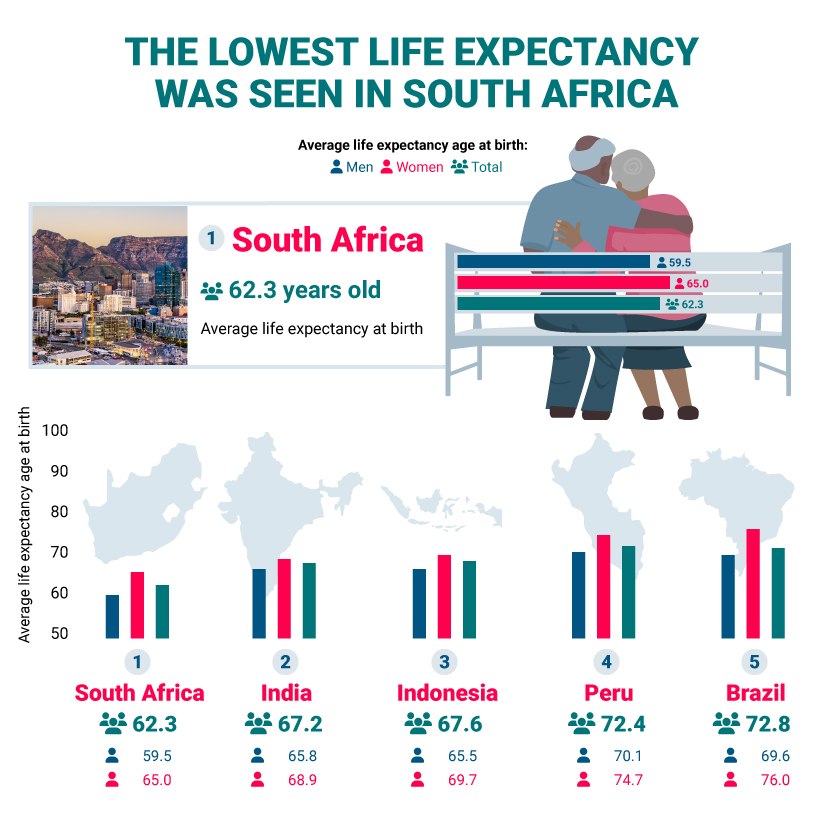

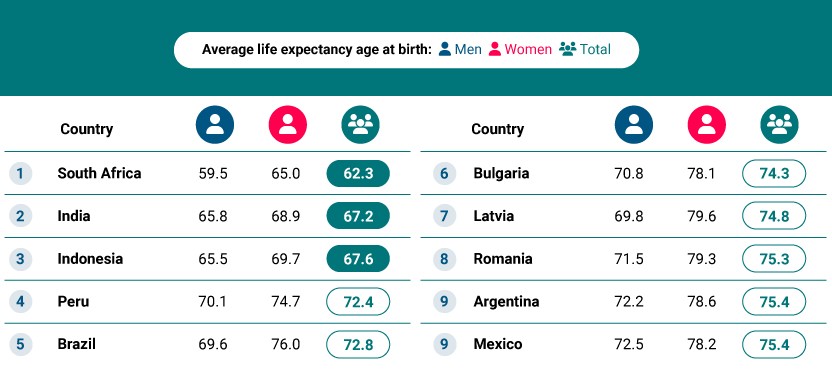

South Africa has the lowest life expectancy in our study, with the average South African expected to live 62.3 years. This is followed by India, with an average life expectancy of 67.2 years, and Indonesia, where this figure stands at 67.6.
The majority of countries featured in the bottom 10, with the exceptions of Latvia and Romania, are classified as middle-income economies by the World Bank. In contrast, all 10 countries with the longest life expectancies are classified as high-income. This suggests that economic prosperity can significantly contribute to average life expectancy, though additional factors will also play a considerable role.
The United States ranks 35th for life expectancy
The United States came 35th out of the 47 countries we examined, with an average life expectancy at birth of 76.4 years, lower than both the median and average figures. Its southern neighbor Mexico saw the ninth-lowest life expectancy at 75.4 years, tying with Argentina while Canada performed quite well, finishing in 17th with an average life expectancy of 81.6.
Japan has the lowest infant mortality rate
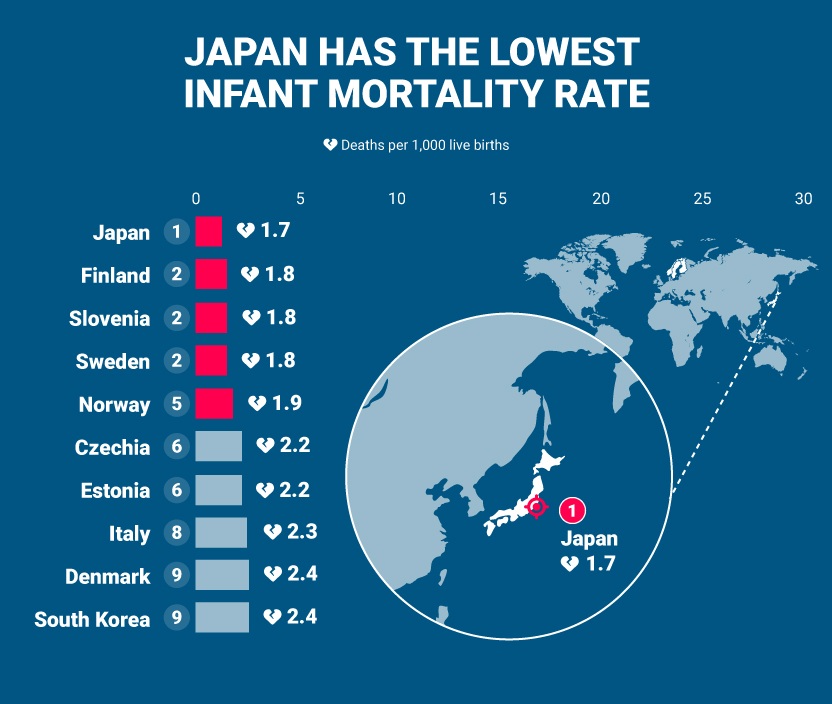

The data for infant mortality rates covered 46 countries, with the average rate standing at 5.8 deaths per 1,000 live births. The median rate across the featured countries was 3.4 deaths per 1,000 live births.
- Japan
Deaths per 1,000 live births: 1.7
According to OECD data, Japan has the lowest infant mortality rate, with just 1.7 deaths per 1,000 live births. While acquiring certain medications in Japan can be more difficult than in many Western countries, Japanese healthcare is considered very high quality.
In Japan, health checks are mandatory for mothers and children, while healthcare is entirely free for infants, all of which could contribute to the country’s low infant mortality rate. It has also been suggested that the Japanese lifestyle, which includes a healthy diet and plenty of physical activity, helps to produce healthier newborns. - Finland, Slovenia & Sweden
Deaths per 1,000 live births: 1.8
Tied in second place are three European countries: Finland, Slovenia, and Sweden. All three countries recorded an infant mortality rate of 1.8 deaths per 1,000 live births. These countries have well-regarded healthcare systems that help ensure newborns' health and well-being, keeping the infant mortality rate low.
South Africa recorded the highest infant mortality rate
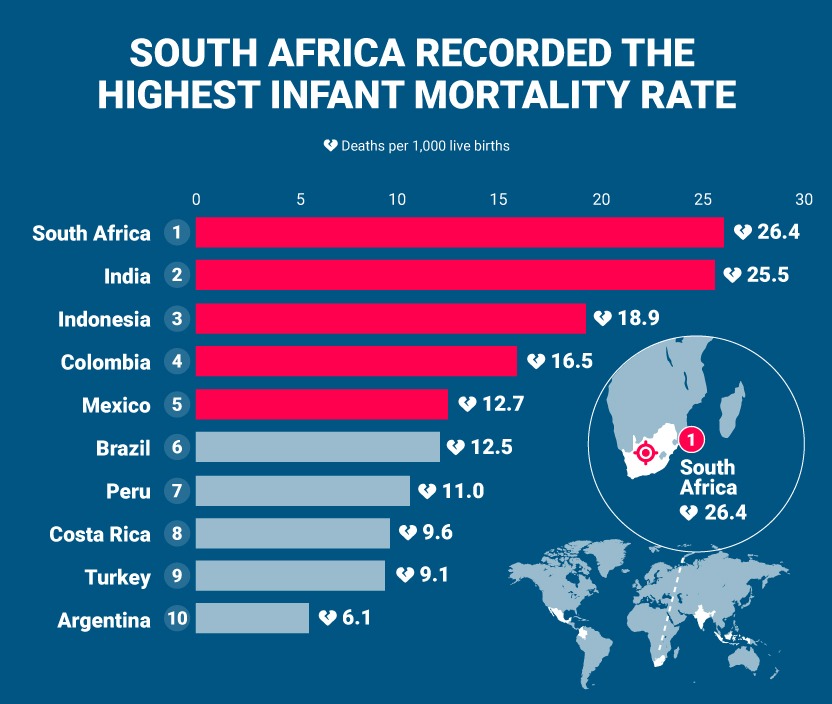

South Africa recorded a very high infant mortality rate of 26.4 deaths per 1,000 live births, which was closely followed by India’s rate of 25.5. These were the only countries to record an infant mortality rate above 20, indicating that both nations have plenty of work to do in improving neonatal care and ensuring the safety of newborns.
How does the United States rank for infant mortality?
The United States took 34th place out of 46 for infant mortality, with an average rate of 5.4 deaths per 1,000 live births. While this is considerably above the median infant mortality rate, it is still below the average due to very high rates seen in South Africa, India, Indonesia, and Colombia.
Luxembourg has the lowest death rate from preventable causes
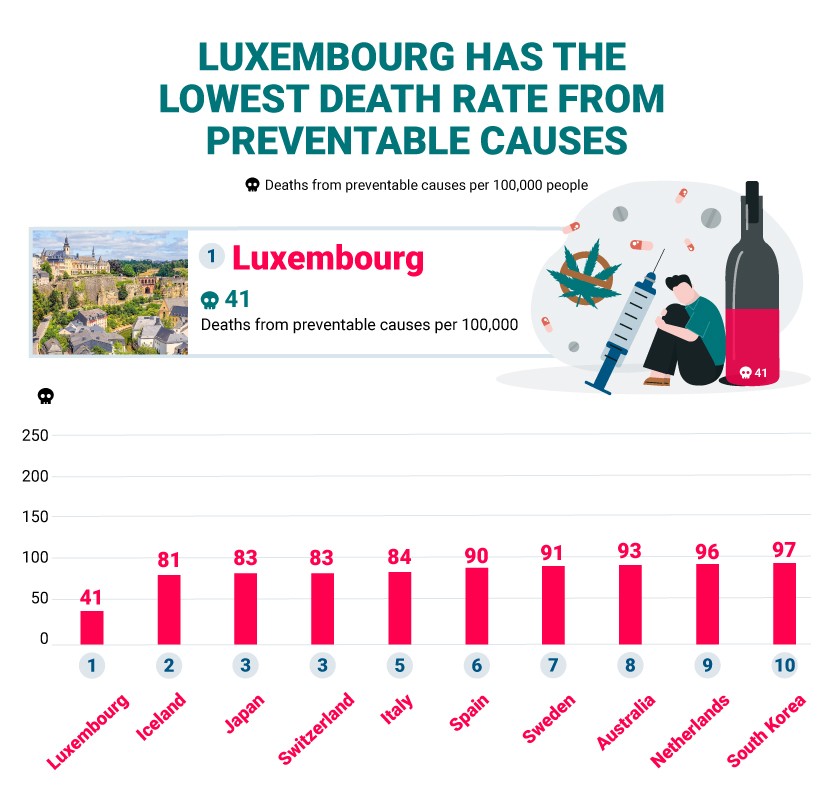

Preventable deaths include a range of different causes, such as lung cancer from smoking, alcohol and substance abuse, injuries and road accidents, and suicide. The OECD data we looked at covered 37 countries, with an average of 128 deaths per 100,000 people and a median of 115.
- Luxembourg
Deaths from preventable causes per 100,000: 41
Luxembourg has the lowest rate of deaths from preventable causes, with just 41 per 100,000 people. This small European state, nestled between Belgium, France, and Germany, has the second-highest GDP per capita in the world, only being beaten by the city-state of Monaco,
raising the local quality of life and helping to fund the country’s fantastic healthcare system.
Luxembourg's healthcare is government-funded and provides coverage for all citizens. Considered one of the best in Europe, it ensures that all Luxembourg citizens can access regular checkups to spot illness and health conditions early. Additionally, the country’s high level of wealth means locals can access good-quality and nutritious foods, gym facilities, leisure sports, and physical activities. - Iceland
Deaths from preventable causes per 100,000: 81
According to the data, Iceland has the second-lowest rate of deaths from preventable causes, with 81 per 100,000 people. Iceland has a publicly funded healthcare system that is accessible to all permanent residents of more than six months. A healthcare system that covers the whole population helps ensure that as many people as possible can speak with a qualified medical professional and maintain a healthy lifestyle.
In addition to the country’s healthcare system, the Icelandic diet and lifestyle might have contributed to the population’s overall health. Icelandic cuisine commonly includes plenty of fresh fish, rich in Omega-3 and fatty acids, and a more limited inclusion of highly processed
foods. Additionally, the Icelandic tradition of mixing saunas and hot baths with cold water immersion is thought to have various health benefits that could contribute to the country’s low rate of deaths from preventable causes. - Japan & Switzerland
Deaths from preventable causes per 100,000: 83
Japan and Switzerland tied for third place, with both nations recording 83 deaths from preventable causes per 100,000 people. As we’ve seen, both Japan and Switzerland are wealthy countries with well-regarded healthcare systems that allow citizens to access regular health checkups.
Additionally, these countries benefit from low levels of pollution, wide areas of pristine natural environments, and cultures that promote active lifestyles, all of which can promote better health and lower the rates of preventable illness.
Latvia saw the highest rate of deaths from preventable causes
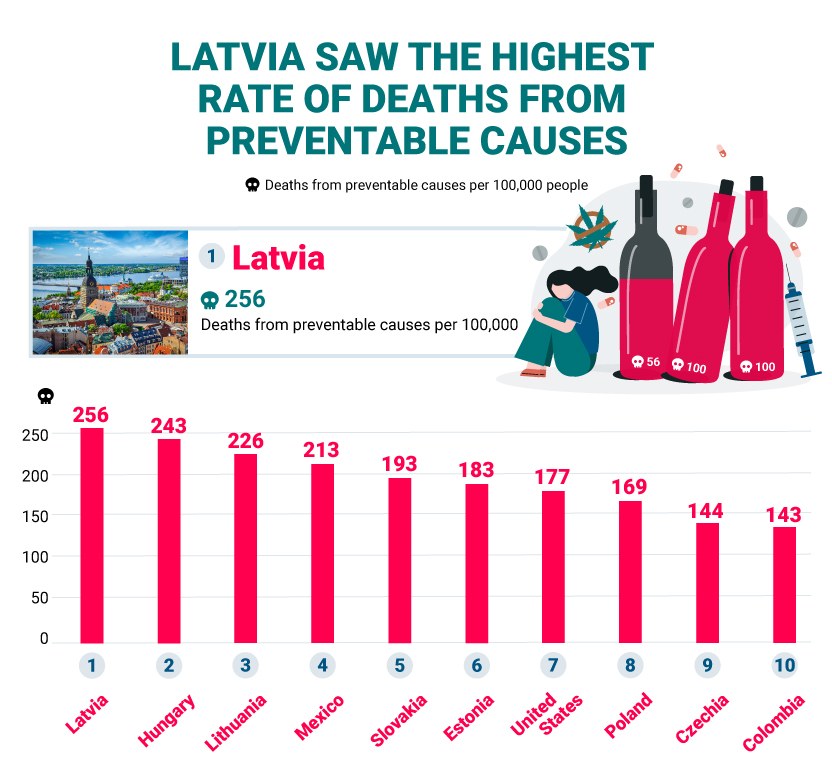

Latvia saw the highest rate of preventable deaths at 256 per 100,000 people, while Hungary, Lithuania, and Mexico also recorded rates above 200. Six of the countries most affected by preventable deaths are in Eastern Europe and the Baltics, suggesting a regional cultural phenomenon fueling the high rates seen here.
Deaths from preventable causes are high in the United States
The United States came 31st out of 37, with one of the highest rates of preventable deaths at 177 per 100,000 people. Preventable deaths include those caused by accidents and lifestyle choices.
Switzerland has the lowest death rate from treatable causes
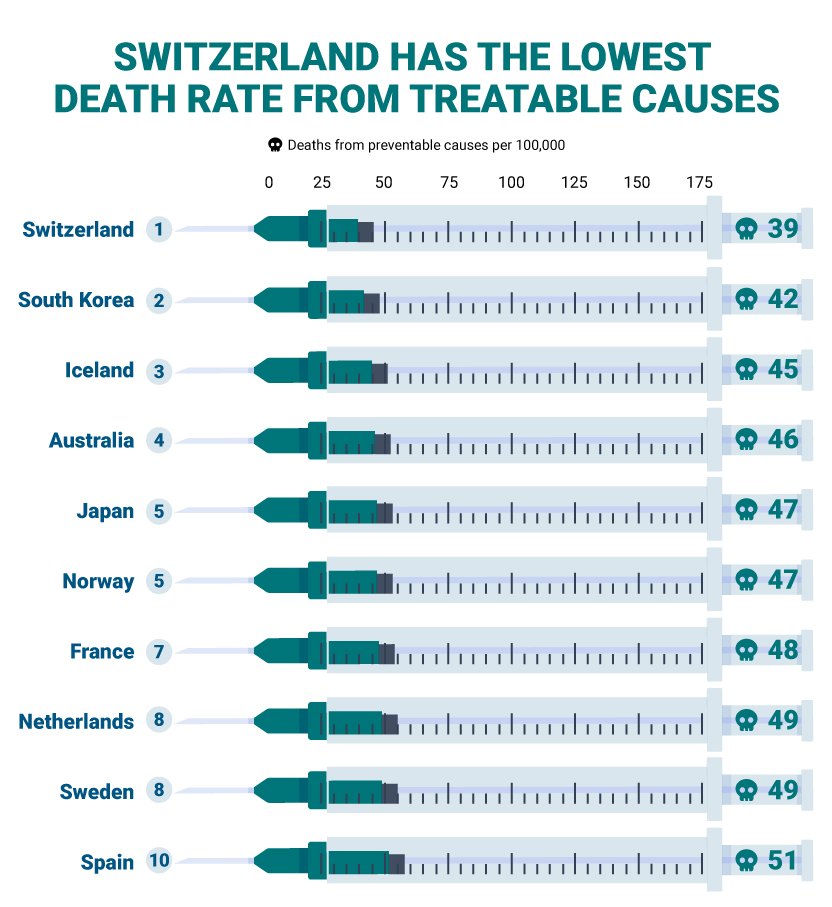

Deaths from treatable causes include those from circulatory diseases, such as heart attacks and strokes, unavoidable cancers, respiratory diseases, diabetes, and many others. All these conditions can arise regardless of personal lifestyle choices. The average death rate from treatable causes across the 37 countries for which we have data is 74 per 100,000 people, while the median rate sits at 62.
- Switzerland
Deaths from treatable causes per 100,000: 39
Switzerland has the lowest rate of deaths from treatable causes, with just 39 per 100,000 people. This is another case of the country’s wealth and top-tier healthcare system leading to positive patient outcomes.
The most common cause of death in Switzerland is heart disease. While this cannot be cured, treatment can be used to manage the symptoms and lessen the chance of heart attacks. - South Korea
Deaths from treatable causes per 100,000: 42
South Korea has the second-lowest rate of deaths from treatable causes, with 42 per 100,000 people. South Korea operates a universal healthcare system that covers nearly all citizens and is compulsory for foreign residents who plan to stay for six months or longer.
Like Switzerland, the most common cause of death in South Korea is heart disease, though the rates are much lower. Closely following heart disease are lower respiratory infections and strokes, both of which are more common than in Switzerland, showing how the countries face differing health challenges. - Iceland
Deaths from treatable causes per 100,000: 45
Iceland has the third-lowest rate of deaths from treatable causes, with 45 deaths per 100,000 people. According to WHO data, Iceland has 45.24 medical doctors per 100,000 people, one of the highest rates in the OECD, making it much easier to book an appointment.
The most common cause of death in Iceland is also heart disease, with the second-highest cause being Alzheimer’s and dementia, which also happens to be the second-highest cause in Switzerland, suggesting this could be a symptom of more Western lifestyles.
Mexico has the highest rate of treatable deaths in the OECD
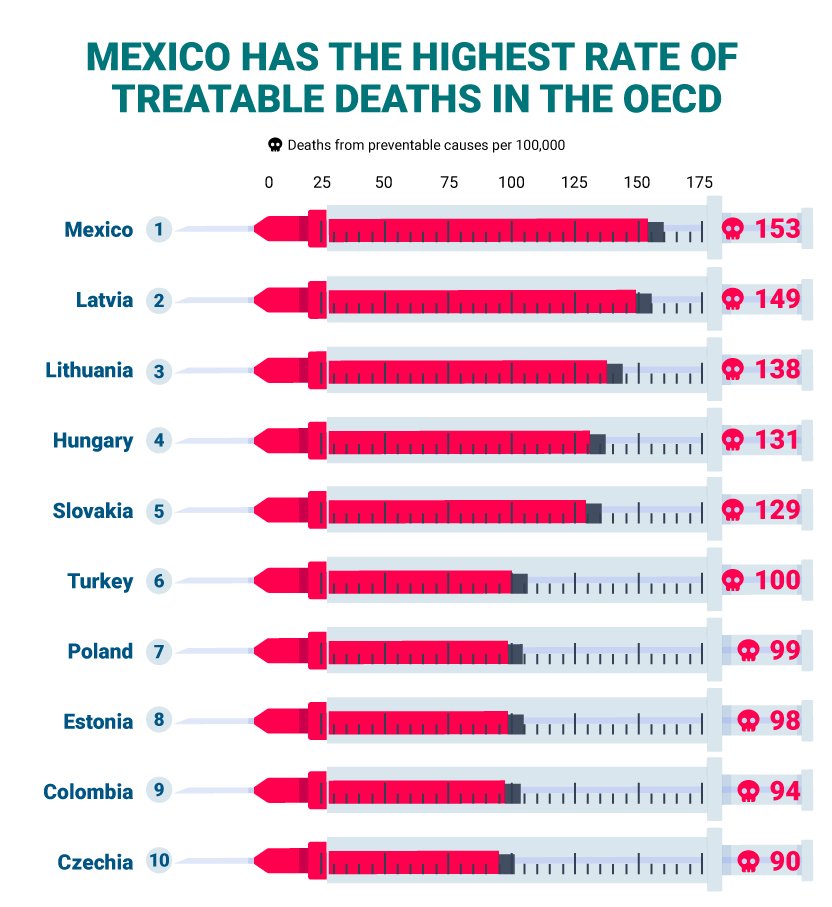

Mexico recorded the highest rate of treatable deaths, with 153 per 100,000 people. This was followed by Latvia and Lithuania, with rates of 149 and 138 deaths per 100,000 people, respectively. In fact, all three Baltic states made an appearance in the bottom 10, with Estonia recording the eighth-highest death rate from treatable causes at 98 per 100,000 people.
It’s interesting to note that the 10 countries with the highest treatable death rates are almost exactly the same as those with the highest preventable death rates. Turkey is the only exception, replacing the United States in the worst countries for treatable deaths with a rate of 100 per 100,000.
Deaths from treatable causes are higher than average in the United States
The United States performed slightly better for deaths from treatable causes than it did for preventable causes, finishing in 26th place with 88 deaths per 100,000 people. However, this death rate is still higher than both the average and median rates, highlighting a significant potential for improvement.
Peru has the lowest death rate from suicide
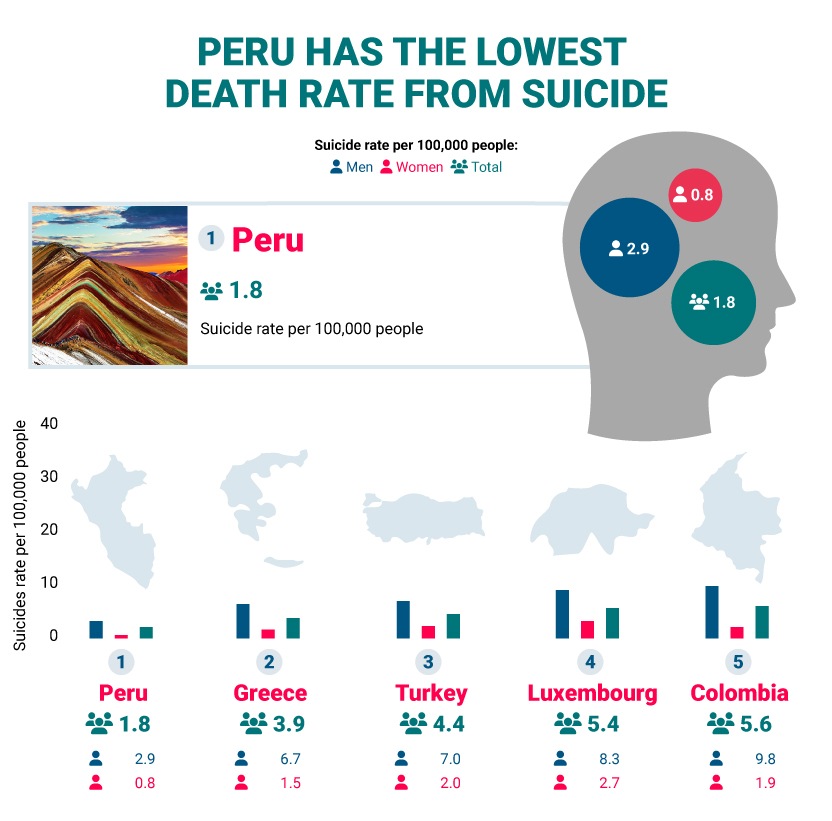

A high rate of deaths from suicide can indicate deep cultural issues and pressures that people struggle to deal with. It also suggests that mental health support in the country is inadequate or that mental health issues are not adequately understood or acted upon. The average rate of deaths from suicide across the 36 countries for which we have OECD data is 10.1 per 100,000 people, while the median rate is 9.9.
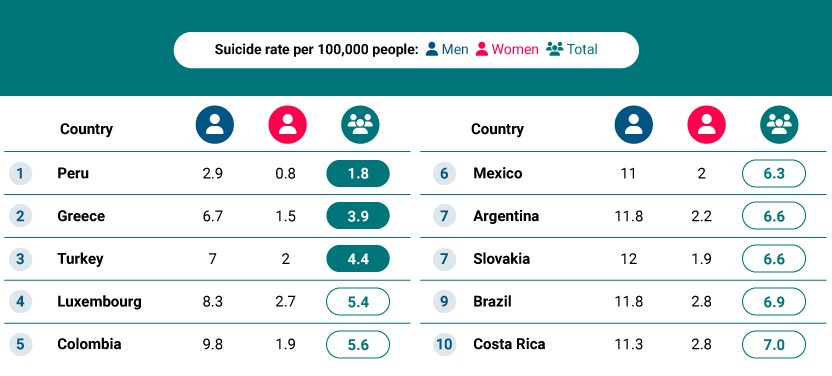

- Peru
Suicide rate per 100,000 people: 1.8
Peru has the lowest suicide rate, according to the data, with just 1.8 instances per 100,000 people. While the male suicide rate in Peru is more than three times that of the female rate, male suicide is far more common across all the countries for which we have data. Peru’s male suicide rate is less than half that of any other country in our study at 2.9 per 100,000, while the country’s female suicide rate is the only one to fall below 1. - Greece
Suicide rate per 100,000 people: 3.9
Greece has the second-lowest suicide rate in our study, with 3.9 cases per 100,000 people. Greece. The male suicide rate in Greece is more than twice that of Peru, with 6.7 instances per 100,000 people, while the female suicide rate is less than a quarter of this at 1.5. The consistently higher male suicide rate shows that there is a widespread need for greater mental support for men and boys regardless of the country they live in. - Turkey
Suicide rate per 100,000 people: 4.4
The third-lowest suicide rate, according to OECD data, is in Turkey, where there are 4.4 cases per 100,000 people. Turkey has a lot of shared history and culture with neighboring Greece, so it’s interesting that the two countries have such similar rates of suicide. This suggests that shared cultural elements could be beneficial for mental health, playing some role in keeping suicide rates low in both countries.
South Korea saw the highest suicide rate in our study
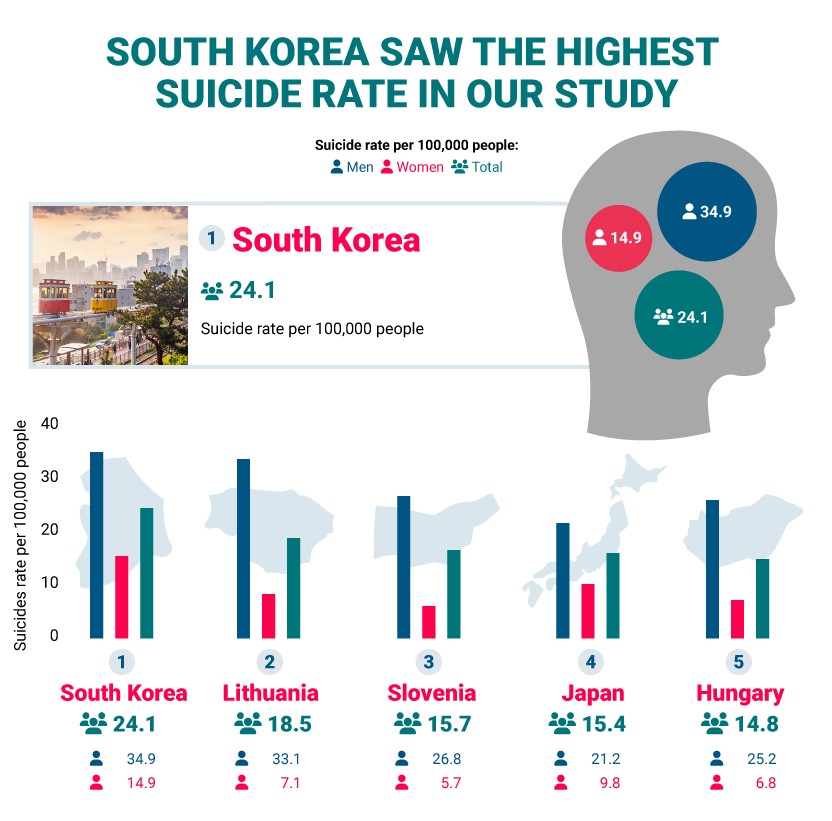

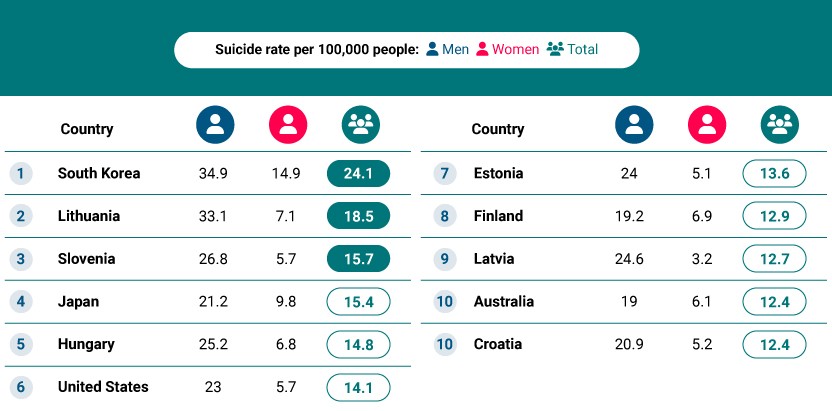

South Korea recorded the highest rate of deaths from suicide at 24.1 per 100,000 people, followed by Lithuania, Slovenia, Japan, and Hungary. This suggests that cultural influences could play a large role in determining suicide rates, as all of these countries are from two specific geographical regions, East Asia and Eastern Europe.
The United States recorded the sixth-highest suicide rate
The United States performed poorly in this factor, taking 31st place with a suicide death rate of 14.1 per 100,000 people. It’s important to note that suicide rates vary wildly from state to state, which could reflect a range of contributing factors such as mental health support, unemployment, drug abuse, and general quality of life.
According to data from the CDC, Montana has the highest suicide rate in the country, with 28.7 deaths per 100,000 people in 2022. An additional three states, Alaska, Wyoming, and New Mexico, also recorded suicide rates higher than the rate seen in South Korea. The lowest suicide rate was seen in New Jersey, with 7.7 deaths per 100,000 people, and was followed by Massachusetts, New York, and Maryland, all of which recorded mortality rates lower than 10.
Mexico has the lowest death rate from cancer
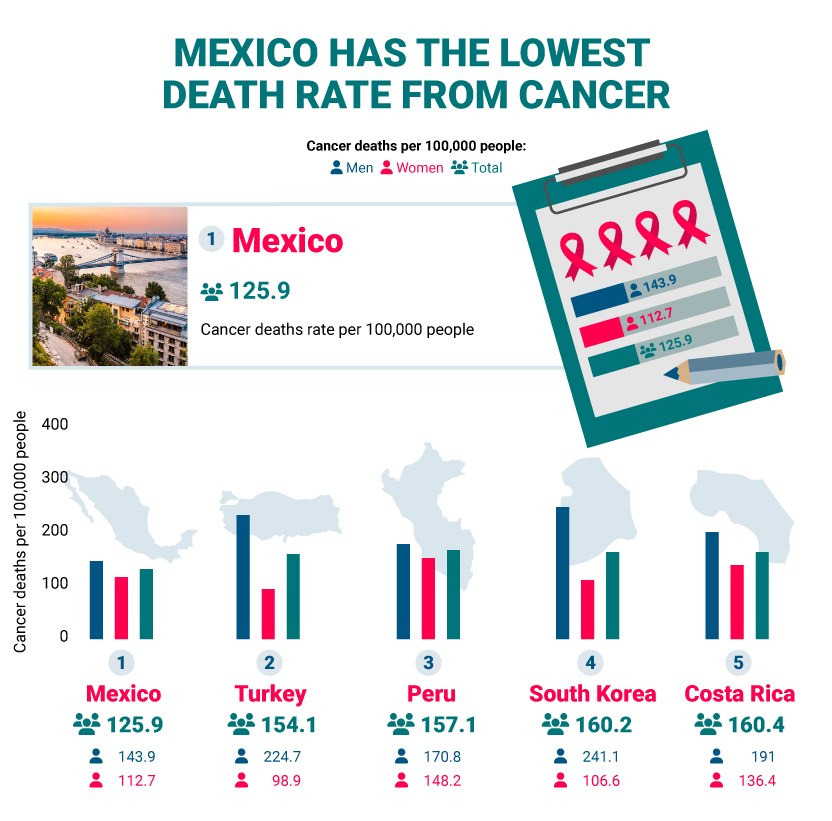

We used OECD data for 36 countries to compare cancer death rates. The average death rate from cancer was 201.2 deaths per 100,000 people, while the median rate was 196.1. While outcomes for cancer patients continue to improve year after year, cancer persists as a major killer all over the world, with many aspects of modern life thought to pose a cancer risk.
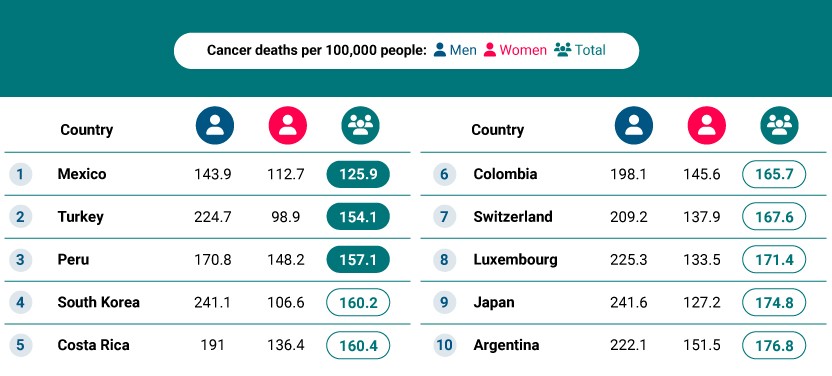

- Mexico
Cancer deaths per 100,000 people: 125.9
Mexico has the lowest rate of cancer deaths at 125.9 per 100,000 people. The rate of cancer deaths in the country is higher for men than it is for women, with 143.9 deaths per 100,000 compared to 112.7 respectively.
Lower risk from factors such as smoking, drinking alcohol, and exposure to harmful UV rays have all been cited as potential reasons for the lower rates of cancer seen in the country. However, there have also been suggestions that the rate could be higher due to issues in how Mexico identifies cancer cases. - Turkey
Cancer deaths per 100,000 people: 154.1
Turkey has the second-lowest rate of cancer deaths in our study, with 154.1 per 100,000 people. Interestingly, cancer rates among Turkish men are far higher than for Turkish women, with 224.7 male cases per 100,000 compared to 98.9 female cases.
As a majority Muslim nation, Turkey has much lower alcohol consumption than most other countries, which could go some way to explaining the low rates of cancer deaths in the country. - Peru
Cancer deaths per 100,000 people: 157.1
Peru has the third-lowest cancer death rate, according to OECD data, with 157.1 cases per 100,000 people. While the average cancer death rate is only slightly higher than Turkey’s, Peru’s female cancer death rate is far higher at 148.2 cases per 100,000 people.
The death rate from cancer in Peru could be lower than in other developed countries due to much less exposure to highly processed foods, which often contain carcinogens and can be harmful if consumed in large quantities.
Hungary recorded the highest death rate from cancer
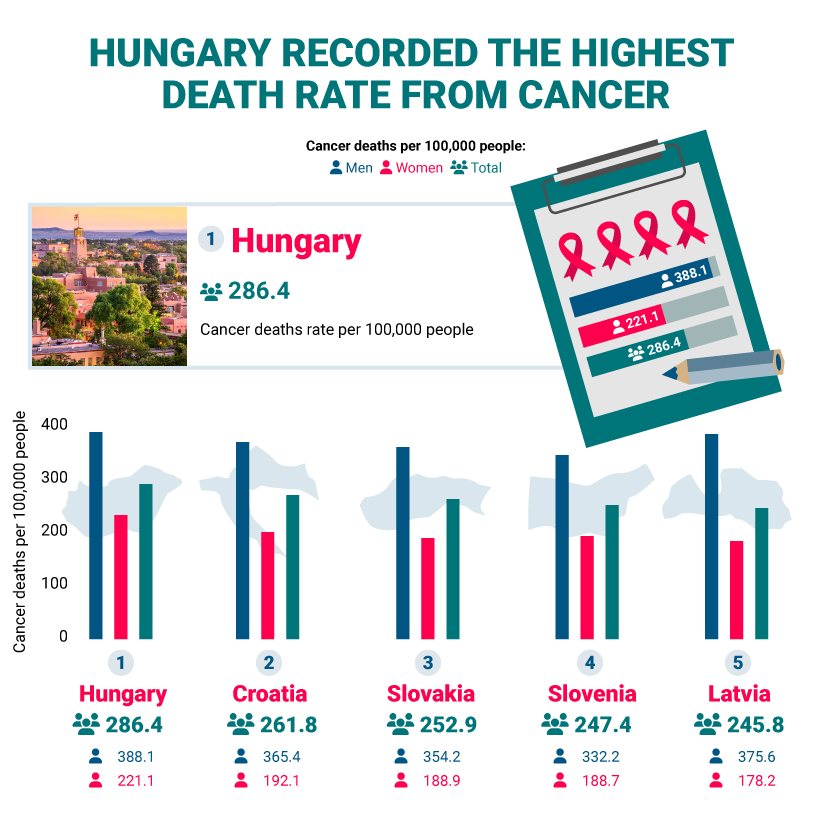

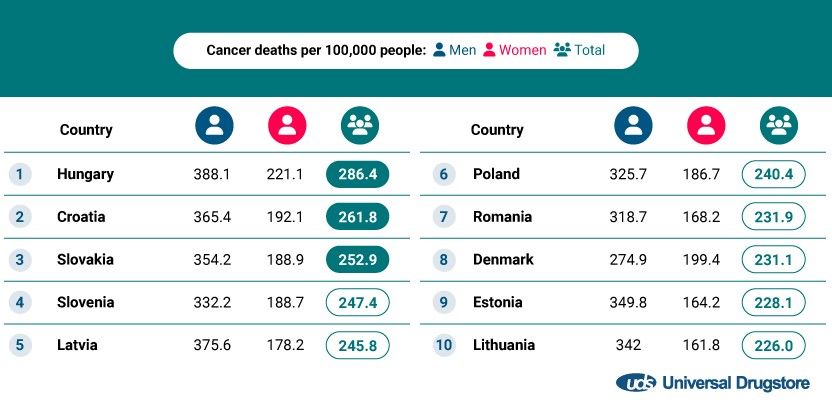

The highest death rate from cancer was seen in Hungary, with 286.4 deaths per 100,000 people. Nearly all of the 10 countries with the highest rates of death from cancer are in Eastern Europe and the Baltics, with Denmark being the only exception. This suggests that common cultural and lifestyle choices, such as diet, could contribute significantly to cancer death rates.
Deaths from cancer
The United States took 14th place with a rate of deaths from cancer of 182.2 per 100,000 people, making it the country’s best-performing category in our study. The rate of cancer deaths was higher among men in every country, standing at 215.1 deaths per 100,000 in the United States compared to a rate of 157.4 for women.
How does life expectancy in the United States compare to otherOECD countries?
The United States is one of the world's wealthiest nations, home to many of the largest pharmaceutical and healthcare companies. In light of this, you may have thought the country would be leading the way in terms of longer life expectancy and lower rates of treatable and preventable deaths.
However, the data in this report shows that the United States has much room for improvement before it catches up with some of the best-performing countries. Sadly, the United States did not make the top 10 list for any of the factors we explored, so just how does the country compare?
Why does the United States perform so poorly?
The United States performed poorly in almost every factor we examined. The country's average life expectancy from birth lags behind most other OECD countries at 76.4 years, while the country’s infant mortality rate, suicide rate, and deaths from preventable and treatable causes were all in the bottom half of the results.
Despite being one of the world's wealthiest countries, the United States has its own unique set of issues that, when combined, could be responsible for this poor longevity.
The high cost of healthcare in the United States
Healthcare in the United States is a contentious issue, with the two main political parties often disagreeing on how it should function. However, one undeniable fact is that the country has exceptionally costly healthcare, frequently costing thousands of dollars for treatments even when the patient has medical insurance. This is in stark contrast to many of the best-performing countries for life expectancy, which offer state-funded healthcare either free at the point of service or subsidized to be affordable for the average user.
The high cost of healthcare in the United States could be preventing some people from seeking medical help when they need it, worsening their health outcomes and sometimes leading to earlier deaths.
In addition to the cost of accessing healthcare, purchasing medication can also pose a financial issue for some, with common medications like asthma inhalers and EpiPens costing hundreds of dollars each. As such, Americans need to find a reliable and affordable pharmacy with affordable prescription drugs, to allow them to manage their health conditions safely without breaking the bank.
Obesity rates are sky-high
While financial issues are important in explaining the United States’ poor life expectancy figures, other factors could be equally influential. Obesity rates in the country are some of the highest in the world, with 41.64% of adult males and 43.82% of adult females being clinically obese. Being obese can lead to several life-threatening health conditions, including heart disease, type 2 diabetes, and strokes.
Several different things, including diet, lack of exercise, and genetics, can cause obesity. While you can’t control your genetics, you can ensure that you live as healthy a lifestyle as possible to limit your chances of becoming obese. However, the United States has a strong driving culture, with many towns and cities built around being able to drive from A to B. This starkly contrasts with many European countries, where people walk much greater distances. Additionally, as the home of fast food, Americans may consume much higher amounts of highly processed food, adversely affecting their health.
Societal issues in the United States
There is also a mix of health issues common in American society but much less prevalent in the other developed countries we looked at. For instance, road deaths in the United States are relatively high at 14.2 per 100,000 people, higher than in Canada, Mexico, Japan, South Korea, and any other European country in our study.
High levels of drug use in the United States are another potential factor contributing to the country’s relatively low life expectancy. As of 2021, the United States was recording 19.5 deaths per 100,000 people from illicit drug use, the highest rate in the world and more than twice the rate of the second-place Canada, where there were 8.9 deaths per 100,000 people.
Violent crime is another major issue in the United States, which can be highlighted by the country’s high rate of deaths from intentional homicide, with 6.4 victims per 100,000 people in 2022. This is much higher than most other nations in our study, which could contribute to the United States’ low life expectancy. The legal availability of firearms in the country is one stark difference between the United States and most other nations we looked at, which could be fuelling the higher rate of homicides.
It’s also important to consider how mental health could affect life expectancy in the United States. The high rate of suicide seen in the data we analyzed suggests that Americans could be facing deeper issues with poorly managed mental health. However, mental health issues can affect far more than suicide rates, as they can fuel other self-destructive behaviors, such as overeating, lack of exercise, drug misuse, and self-harm.
Methodology
We used OECD data to compare the average life expectancy at birth across different countries, highlighting those with the longest-predicted lifespans. This was then followed by further OECD data, comparing countries based on their death rates from several different causes:
- Infant mortality per 1,000 live births
- Deaths from preventable causes per 100,000 people
- Deaths from treatable causes per 100,000 people
- Death from suicide per 100,000 people
- Deaths from cancer per 100,000 people
We then revealed the countries with the lowest death rates for each factor. The most recent data was used for each country within each factor, ranging from 2019 to 2022. All data for deaths from preventable and treatable was for 2019. Russia and Israel were removed from our datasets due to their ongoing involvement in international conflicts.
The data for the United States was then explored in greater detail, comparing life expectancy and death rates to those of other countries in the data and to overall averages and medians for each factor.
This was then followed by an exploration of some of the potential causes of the low life expectancy in the United States.
Listed below are several additional sources used to inform discussion around the data contained in this study.
Statista - United States’s share of the global pharmaceutical industry
World Bank - GDP per capita by country
WHO - Medical doctors per 100,000 people by country
Global Obesity Observatory - Obesity rates by country
WHO - Road traffic death rate by country
Our World In Data - deaths from illicit drug use by country
United Nations - Victims of intentional homicide by country
CDC - Suicide mortality rates by state








